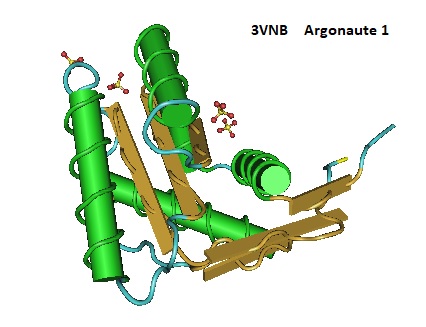A technique called CLASH as described in 2014 by Helwak and Tollervey allows high-throughput identification of RNA-RNA interaction sites without bioinformatic predictions. Next-generation deep sequencing has revealed that most of the eukaryotic genome is transcribed. However, the biological functions of the majority of transcripts are not known yet. MicroRNAs (miRNAs) play a key role in gene regulation. Therefore Tollervey’s group developed a technique for ligation and sequencing of miRNA-target RNA duplexes associated with the human Argonaut protein AGO1. The goal for the development of this method was to provide an unbiased view of human miRNA targets since the reliable bioinformatic or experimental identification of their targets is still difficult.

Figure 1: Crystal structure of Arabidopsis Ago1 Mid domain.
MiRNAs play key roles in the posttranscriptional regulation of gene expression by guiding the association between the RNA-induced silencing complex (RISC) and target RNAs. More than 1,000 miRNAs are expressed in human cells. Each miRNA can potentially bind to hundreds of messenger RNAs (mRNAs) however, only a small fraction of these interactions has been validated experimentally.
CLASH allows studying the human miRNA interactome as well as other RNA interactomes or RNA-RNA interactions in cells. The method relies on UV based cross-linking of a tagged bait protein in vivo to stabilize RNA interaction that can be purified under denaturing conditions.
The following is a brief overview of the Experimental and Bioinformatic Procedure as described by Helwak et al. in 2013.
(A) Growing cells are UV irradiated, and the Argonoute-TEV cleavage site-His6 tripartite tag (PTH-AGO1) is purified. RNA fragmentation, ligation, cDNA synthesis, and sequencing of AGO1-associated RNAs allows the identification of sites of AGO1 binding as well as RNA-RNA interactions at AGO1-binding sites.
(B) Sequencing reads are mapped to a database of human transcripts using BLAST. Sequences reliably mapped to two different sites are folded in silico using UNAFold to identify the interaction site of the RNA molecules that gave rise to the chimeric cDNA.
During CLASH, RNAs associated with the bait protein are partially truncated, and the ends of RNA-duplexes are ligated together. Next linkers are added, cDNA libraries are prepared and high-throughput sequencing is performed. The ligated duplexes give rise to chimeric cDNAs and unambiguously identify RNA-RNA interaction sites independent of bioinformatic predictions.
CLASH has various significant features:
1. UV irradiation specifically stabilizes direct protein-RNA interactions. When applied to live cells the recovered complexes should represent a snap-shot of physiological interactions.
2. Protein-RNA complexes are purified stringently under denaturing conditions.
3. Several samples can be prepared in parallel.
4. According to the authors, the CLASH method is flexible and adaptable to the analysis of other RNA-RNA interactions.
Reference
Helwak A, Tollervey D. Mapping the miRNA interactome by cross-linking ligation and sequencing of hybrids (CLASH). Nat Protoc. 2014 Mar;9(3):711-28. doi: 10.1038/nprot.2014.043. Epub 2014 Feb 27. PubMed PMID: 24577361; PubMed Central PMCID: PMC4033841. https://www.ncbi.nlm.nih.gov/pmc/articles/PMC4033841/
Helwak A, Kudla G, Dudnakova T, Tollervey D. Mapping the Human miRNA Interactome by CLASH Reveals Frequent Noncanonical Binding. Cell. 2013;153:654–65.[PMC free article] [PubMed]
https://www.ncbi.nlm.nih.gov/Structure/pdb/3VNB
https://www.ncbi.nlm.nih.gov/pubmed/29447113 Niaz S.; The AGO proteins: an overview. Biol Chem. 2018 May 24;399(6):525-547. doi: 10.1515/hsz-2017-0329.
---…---